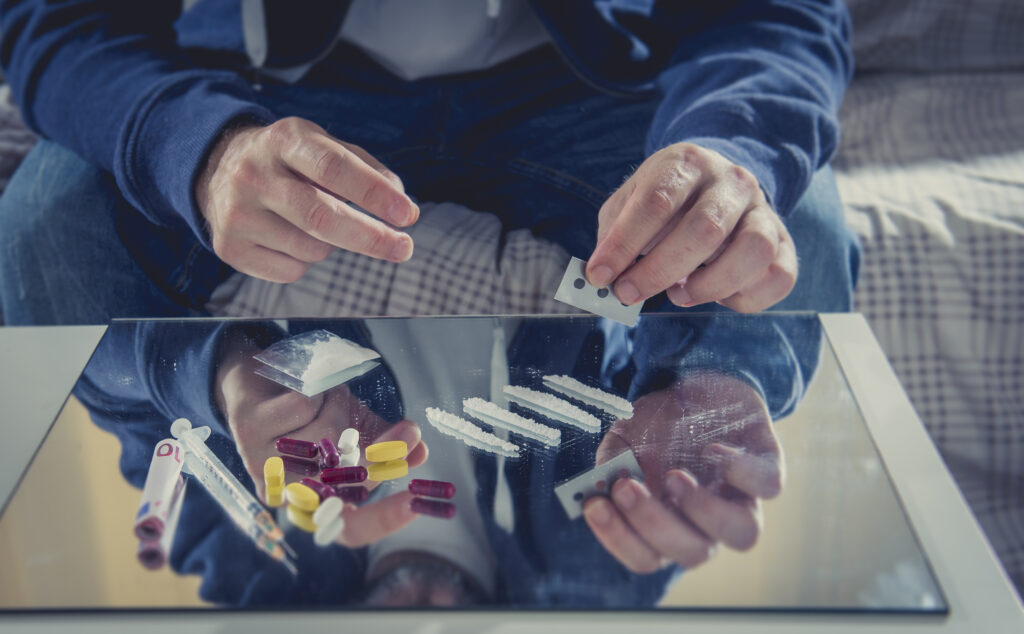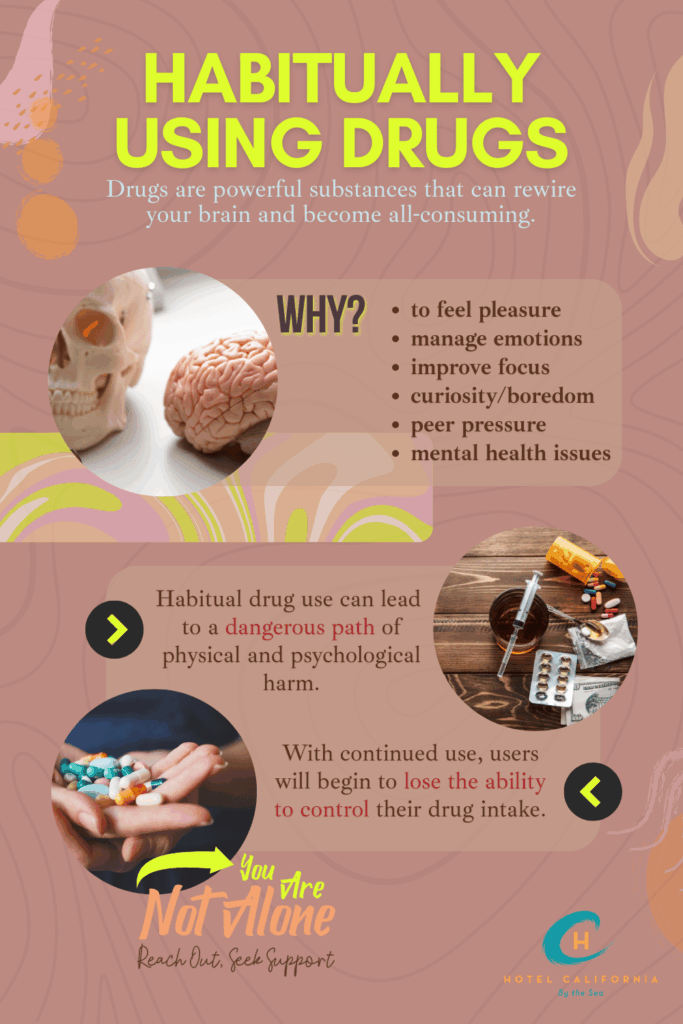Breaking the Cycle of Habitually Using Drugs
Casual drug use can easily turn into habitually using drugs, which can easily turn into a full-blown drug addiction. Addiction is a chronic relapsing mental health disorder that is associated with compulsive drug-seeking behavior. It is characterized by a loss of control over drug intake and the emergence of negative consequences when the drug is no longer available for use. Habitual drug use can lead to a dangerous path of physical and psychological harm.

Addiction is a brain disease that occurs in stages. Each stage of the disease involves complex interactions between brain circuits and their corresponding behaviors. Addiction also occurs in a cycle. It is a process in which every addict will experience, starting from initial drug use to drug abuse, to drug addiction and then relapse.
An addiction to drugs, or a substance use disorder, is the inability to stop or control drug use despite resulting in adverse social, occupational and medical health consequences. Substance use disorders can range from mild to moderate to severe.
The Impact of Drug Use
Substances like drugs and alcohol can have a powerful effect on the brain. Drugs produce pleasurable feelings and blunt out negative feelings in the brain. These feelings can become so powerful that they motivate users to continue drug use despite the risks of harm to their well-being.
Drugs work by interfering with the way neurons in the brain send, receive and process signals from neurotransmitters. This is because drugs can mimic the brain’s own natural neurochemicals. They do not activate neurons in the same way as natural neurotransmitters. Because of this, it can lead to abnormal messages being sent throughout the brain network.
How do drugs produce pleasure?
The feeling of pleasure is how the brain can identify and reinforce beneficial behaviors such as eating, socializing and sex. Pleasure and euphoria from drug use are still not fully understood. Researchers believe it involves the large surges of chemical signaling compounds that are similar to the body’s natural opioids. Our brain is wired to increase the odds of us repeating pleasurable activities.
If drugs can produce pleasure just as the body naturally does, why are they more addictive than natural rewards? The difference between normal rewards and drug rewards can be very different. When a person who misuses drugs eventually stops, they can begin to feel empty, without motivation, lifeless or depressed. They are unable to enjoy the things they once loved. This feeling of emptiness and depression motivates the user to seek out more drugs and continue drug use in an attempt to feel temporary pleasure.

What happens when you start habitually using drugs?
How does drug use become a habit? Habitual drug use is the persistent and often compulsive consumption of potent and mind-altering drugs. It can manifest in repetitive and specific patterns that can lead to serious health side effects, social and psychological consequences.
Habitual drug use can emerge from various factors. These factors include genetic predisposition and genetics, neurobiological factors, mental health disorders, trauma and abuse. Habitually using drugs can also lead to a range of physical, behavioral, and psychological health issues.
Why do People start using Drugs?
Drug use occurs for a number of different reasons. It can be to feel good and produce feelings of pleasure. It can be used to help manage stress and anxiety. It can be used to improve focus in school or at work. It can be used out of genuine curiosity. Or it can be used out of social peer pressure.
The initial decision to use drugs is typically voluntary. However, with continued use, users will begin to lose the ability to control their drug intake. This can lead to serious impairments, both physically and psychologically.
The 5 Stages of Addiction
Substance addiction generally occurs in stages. There is no timeline for when and how long each stage lasts. They can occur over a short period of time or over a longer period. And in some cases, the last stage of relapse never occurs. Users will often go through multiple cycles of the stages of addiction, causing constant habitual drug use.
- The first stage of addiction is initial use. It is the person’s intro to drugs and alcohol. It can be through a prescribed medication, out of boredom or out of curiosity. It can take as little as one rush of dopamine to the brain for the person to become hooked.
- The second stage of addiction is abuse. This is when the person begins to repeatedly use drugs to feel positive effects. This can be because they are using it to deal with emotions. Users are unable to control their use and they are constantly thinking about using.
- The next stage of addiction is tolerance and dependence. By this time, users are usually very regular and have developed a tolerance, causing physical or psychological dependence. The brain now needs more of the drug in order to achieve the same effects and to function normally.
- The fourth stage is the stage of addiction. The addictive behaviors become so severe that the person is unable to function with their drug of choice. Health, finance and social lives are impacted. They experience intense drug cravings and experience withdrawal if they attempt to stop drug use.
- The last stage of addiction is relapse. Not everyone goes through relapse, but the majority of those going through addiction do. In some cases of addiction, withdrawal can be so intense that it may cause the user to return to drug use in order to avoid uncomfortable withdrawal. According to the National Institute on Drug Abuse, an estimated 40-60% of substance abusers relapse.
Check Your Insurance Coverage for FREE
Find out if your insurance covers addiction treatment in minutes. We accept most insurance!
How Habitually using Drugs can impact the workplace
When you become addicted to drugs, it can be an all-consuming condition. A condition that can follow you even into the workplace. Unaddressed drug addiction can have a severe impact on the workplace.
Research found that more than 70% of those with an alcohol or drug addiction continue to maintain regular employment because they remain “functional.” That comes to around 14.8 million Americans. Addiction costs American businesses and organizations an average of $81 billion in lost profits every year.
What is the impact of drug addiction in the workplace?
- Lethargy and short-term cognitive impairment
- Tardiness and increased absenteeism
- Loss in productivity
- Higher turnover rates
- Theft in the workplace
- Decrease in the quality of work and overall job performance
- Poor decision-making
- Loss of efficiency
- Lower morale of co-workers
- Increased likelihood of getting in trouble with other co-workers
- Preoccupation with drug use
- Illegal activities at work
How can employers and businesses address the drug problem?
Some companies and businesses have what is called an Employee Assistance Program (EAP). The EAP covers a wide range of issues. It can provide employees with short-term counseling, assessments and referrals to a substance addiction treatment facility, it can help with financial issues and can also help with mental health issues. These services are meant to be confidential and to further assist employees who may be struggling with a behavioral issue like addiction.
Research has found that companies and businesses that invest in employee wellness and treatments tend to yield high returns. It helps increase employees’ legal, mental and social functioning, resulting in a positive return on investment for the company.
Reach out to Hotel California by the Sea
We specialize in treating addiction and other co-occurring disorders, such as PTSD. Our Admissions specialists are available to walk you through the best options for treating your addiction.
Treatment for Substance Use Disorder
Habitually using drugs can lead to a dangerous path of addiction that can impact various aspects of a person’s life. Drugs are powerful substances that can rewire your brain. It can impact you physically and emotionally, leading to behaviors that are harmful and risky. Professional behavioral treatment programs such as Hotel California by the Sea provide services to help those with a substance use disorder.
We offer treatment at all levels of care including detox, residential, PHP and IOP. We utilize evidence-based treatment methods such as CBT, DBT and EMDR therapy. Hotel California by the Sea is dedicated to helping our clients reach their goals of sobriety and overcome their addiction.
References:
https://www.niaaa.nih.gov/publications/cycle-alcohol-addiction
https://www.addictionhelp.com/addiction/stages
https://nida.nih.gov/publications/drugs-brains-behavior-science-addiction/drug-misuse-addiction
https://www.health.harvard.edu/blog/working-on-addiction-in-the-workplace-2017063011941
https://ncaddnational.org/addiction_articles/drugs-and-alcohol-in-the-workplace/
